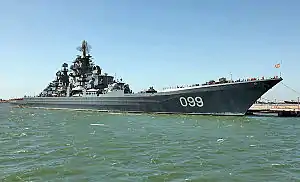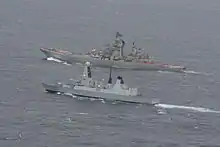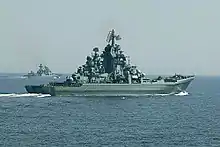Russian battlecruiser Pyotr Velikiy
Pyotr Velikiy (Russian: Пётр Великий) is the fourth Kirov-class battlecruiser of the Russian Navy. It was initially named Yuri Andropov (Russian: Юрий Андропов) for Yuri Andropov, the former General Secretary of the Communist Party, but the ship's name was changed after the fall of the Soviet Union. The Russian designation for the type is "heavy nuclear missile cruiser", but Western defense commentators have resurrected the term "battlecruiser" to describe them, as they are the largest surface combatant warships in the world. Pyotr Velikiy is the flagship of the Northern Fleet.
 | |
| History | |
|---|---|
| Name: | Pyotr Velikiy |
| Namesake: | Peter the Great |
| Builder: | Baltic Shipyard , designer Severnoe PKB |
| Laid down: | 1986 |
| Launched: | 1996 |
| Commissioned: | 18 April 1998 |
| Status: | in active service |
| General characteristics | |
| Class and type: | Kirov-class battlecruiser |
| Displacement: |
|
| Length: |
|
| Beam: | 28.5 m (94 ft) |
| Draft: | 9.1 m (30 ft) |
| Installed power: | 140,000 shp (100,000 kW) |
| Propulsion: | 2-shaft, nuclear propulsion with steam turbine boost |
| Speed: | 32 knots (59 km/h) |
| Range: |
|
| Complement: |
|
| Sensors and processing systems: |
|
| Armament: |
|
| Armour: | 76 mm plating around reactor compartment, light splinter protection |
| Aircraft carried: | 3 × Kamov Ka-27 "Helix" or Ka-25 "Hormone" |
| Aviation facilities: | Below-deck hangar |
Construction of the ship was delayed by lack of funding due to the national economic problems before and after the fall of the Soviet Union. It was not completed and commissioned until 1998, twelve years after work had started. By then it had been renamed Pyotr Velikiy, Russian for Peter the Great. Pyotr Velikiy has been known to carry two pennant numbers during its service: "183" and currently "099".
Service history
After completing its acceptance trials in November 1996, the vessel was transferred to the Northern Fleet at Severomorsk and was designated as the flagship of the Northern Fleet.
In August 2000 Pyotr Velikiy was in the Barents Sea to oversee the largest naval training exercise in a decade, since the fall of the Soviet Union. The ship was to be the designated target of the Oscar-II class submarine K-141 Kursk, and was conducting evasive maneuvers when communication with Kursk was lost. The submarine was later found to have suffered catastrophic torpedo detonations, resulting in the loss of all 118 crew members. Pyotr Velikiy guarded the area where the submarine sank during the subsequent salvage operation in 2001.
In March 2004, Russian Navy Chief Admiral Vladimir Kuroyedov declared Pyotr Velikiy unfit for service due to problems with the ship's engineering maintenance.[1] On 19 April 2004, the cruiser was docked in the floating drydock PD-50 for painting of the underside of the hull, repairs, and examination of the steering system. The repairs were completed later that year, and it was carrying out missions again by August.
From September 21 to October 22, 2004 she sailed on her first long voyage. Accompanying the aircraft carrier Admiral Kuznetsov, the destroyers Admiral Chabanenko and Admiral Ushakov, as well as several auxiliary ships, she went into the north-western Atlantic in what was the largest Russian naval exercise after the end of the Cold war.[2][3]
2008–2009
On 8 September 2008, it was announced that Pyotr Velikiy would sail to the Caribbean Sea to participate in naval exercises with the Venezuelan Navy, along with the destroyer Admiral Chabanenko and other support ships. This action would represent the first major Russian show of force in the Caribbean since the end of the Cold War.[4] On 22 September Pyotr Velikiy and Admiral Chabanenko left their homeport of Severomorsk.[5]
On 22 October 2008 Pyotr Velikiy made a port visit to Aksaz Karagac, Turkey[6] and on 6–9 November the cruiser and Admiral Chabanenko made a port visit to Toulon, France,[7] before departing the Mediterranean on 10 November, passing through the Strait of Gibraltar.[8]
Pyotr Velikiy arrived in La Guaira, Venezuela on 25 November 2008[9] coinciding with a visit by Russian President Dmitry Medvedev. A combined exercise, VENRUS-200, with the Venezuelan Navy took place on 1–2 December 2008.[10] After finishing the exercises, Admiral Chabanenko made a short visit to Panama 5–10 December, then to Bluefields, Nicaragua from 13 to 15 December[11] and sailed into Havana, Cuba on 19 December.[12]
Pyotr Velikiy continued alone to Cape Town, South Africa. On 11 January 2009, the chief of the Russian General Staff announced that Pyotr Velikiy and six other Russian warships would participate in a joint naval exercise with the Indian Navy later the same month.[13] The Kirov-class cruiser paused for three days to visit Cape Town before continuing on to India.[14]
On 31 January Pyotr Velikiy left the port of Mormugao in the Indian state of Goa. After a two-day visit that included a naval exercise with the Indian guided-missile destroyer INS Delhi the cruiser left for African waters where the vessel joined other warships from the Russian navy and conduct the INDRA-2009 exercise.[15][16]
On 12 February, the ship captured 10 pirates in three boats off the coast of Somalia.[17]
On 10 March Pyotr Velikiy returned to its homeport of Severomorsk, ending a six-month deployment.[18]
2010

On 30 March 2010 Pyotr Velikiy left the Northern Fleet for a new six-month deployment. During its six-month tour of duty, the warship passed through the Atlantic Ocean and the Mediterranean Sea before entering the Indian Ocean via the Suez Canal. In the Indian Ocean the cruiser conducted maneuvers with other Russian warships from the Black Sea Fleet.[19]
On 14 April the missile cruiser visited the Mediterranean port of Tartus in Syria. In September 2008, Russia was reported to be in talks with Syria about turning Tartus into a permanent base for Russian warships in the Middle East.[20]
In early May 2010 Pyotr Velikiy met up with the cruiser Moskva in the South China Sea. There they conducted joint exercises and held a traditional farewell ceremony on 5 May. The two vessels were due to arrive in Russia's Far Eastern port of Vladivostok to take part in the Vostok-2010 large-scale strategic exercise.[21]
On 29 September Pyotr Velikiy returned to its home base in the Northern Fleet after six months at sea. The flagship of the Northern Fleet had covered about 28,000 nautical miles (52,000 km; 32,000 mi) since the beginning of the mission on 30 March.[22]
2013
During early September 2013 Pyotr Velikiy led a flotilla of Russian Navy ships through the Russian portion of the Northern Sea Route in preparation for establishment of regular patrols.[23]
2014
Pyotr Velikiy along with the aircraft carrier Admiral Kuznetsov and the tankers Sergey Osipov, Kama and Dubna; the tugboat Altay, and the Ropucha-class landing ship Minsk (122) entered the English Channel to sail north.[24] The British destroyer HMS Dragon monitored the Russian task group as it neared the United Kingdom. Once the ships spotted each other they sailed briefly close by as a standard 'meet and greet'.
2016
In May 2016 Pyotr Velikiy put to sea for the first time in two years for drills off the coast of Northern Russia.[25] On October the 15th Pyotr Velikiy left Severomorsk to escort Admiral Kuznetsov to the Mediterranean along with supply ships and two Udaloy class destroyers, Severomorsk and Vice-Admiral Kulakov. They were heading to the Eastern Mediterranean to support Syrian government forces battling rebel troops in Aleppo. Pyotr Velikiy passed through the English Channel, along with the rest of the Russian Northern Fleet on 21 October, shadowed by the British destroyer HMS Dragon.[26]
Gallery
 Ship's crew
Ship's crew Russian president Vladimir Putin visiting Pyotr Velikiy
Russian president Vladimir Putin visiting Pyotr Velikiy The cruiser in May 2010, doing an exercise on radiological, chemical and biological protection
The cruiser in May 2010, doing an exercise on radiological, chemical and biological protection The cruiser during tactical exercises of the Baltic and Northern Fleets
The cruiser during tactical exercises of the Baltic and Northern Fleets
References
- "Nuclear battle cruiser 'in danger of exploding'". The Sydney Morning Herald. Associated Press. 2004-03-24. Archived from the original on 2008-09-26. Retrieved 2008-09-22.
- https://web.archive.org/web/20041107044237/http://www.cdi.org/russia/329-9.cfm
- ru:Маршал Устинов (ракетный крейсер)
- Sweeney, Conor (2008-09-08). "Russia says to send battleship to Caribbean Sea". Reuters. Retrieved 2009-01-06.
- Moscow Interfax-AVN Online in Russian 1102 GMT 10 March 09
- Moscow Vesti TV in Russian 2100 GMT 22 October 08
- Moscow Zvezda Television in Russian 1900 GMT 06 November 08
- St Petersburg Rosbalt-Sever in Russian 11 November 08
- Moscow Zvezda TV in Russian 1304 GMT 25 November 08
- Moscow Kommersant Daily, in Russian, 03 December 08
- Moscow Vremya Novostey in Russian 15 December 08
- "Russian Destroyers Pull In To Havana". CBS News. December 19, 2008. Archived from the original on September 28, 2018. Retrieved September 27, 2018.
- "Six Russian warships to take part in joint drills with India navy". RIA Novosti. 2009-01-11. Archived from the original on 2009-01-22. Retrieved 2009-01-20.
- "Russian warship leaves Cape Town for Indian Ocean". RIA Novosti. 2009-01-15. Archived from the original on 2009-01-25. Retrieved 2009-01-20.
- "Russian cruiser Pyotr Veliky leaves India | Russia | RIA Novosti". En.rian.ru. 2009-01-31. Archived from the original on 2011-02-04. Retrieved 2010-06-08.
- 8/6/2010 13:36. "Russian cruiser Pyotr Veliky in India | Video | RIA Novosti". En.rian.ru. Archived from the original on 2011-06-05. Retrieved 2010-06-08.CS1 maint: numeric names: authors list (link)
- James Kilner (February 13, 2009). "Russian warship seizes 3 pirate ships off Somalia". Reuters. Archived from the original on February 16, 2009. Retrieved June 8, 2010.
- Moscow Vesti TV in Russian 1436 GMT 11 March 09
- "Russia's Pyotr Veliky nuclear-powered cruiser crosses English Channel | Russia | RIA Novosti". En.rian.ru. Archived from the original on 2010-05-02. Retrieved 2010-06-08.
- "Russian nuclear cruiser makes port call in Syria | Defense | RIA Novosti". En.rian.ru. 2010-04-14. Archived from the original on 2010-05-29. Retrieved 2010-06-08.
- "Russian missile cruisers complete joint exercises | Russia | RIA Novosti". En.rian.ru. Archived from the original on 2010-05-15. Retrieved 2010-06-08.
- "Russia's most powerful warship returns home after tour-of-duty | Defense | RIA Novosti". En.rian.ru. Archived from the original on 2012-01-06. Retrieved 2011-12-31.
- Andrew E. Kramer (September 14, 2013). "Russia Preparing Patrols of Arctic Shipping Lanes". The New York Times. Archived from the original on September 18, 2013. Retrieved September 15, 2013.
- "Royal Navy sails to meet Russian Task Group". mod.uk. Archived from the original on 2014-05-13. Retrieved 2014-05-09.
- "Russia's Northern Fleet flagship goes to sea first time in 2 years". Archived from the original on 2016-08-25. Retrieved 2017-06-05.
- "Russian warships sailing through English Channel 'a smokescreen' for something else entirely". The Independent. 2016-10-21. Archived from the original on 2017-04-14. Retrieved 2017-04-13.
- "Атомный крейсер "Петр Великий" отстреляется в Баренцевом море". Российская газета. Retrieved 2020-03-22.
- https://structure.mil.ru/structure/forces/navy/news/more.htm?id=12256319@egNews
External links
| Wikimedia Commons has media related to Pyotr Velikiy (ship, 1996). |
- Federation of American Scientists – Kirov Class
- "Type 1144 "Kirov" Class". Archived from the original on August 23, 2001. Retrieved February 2, 2006.